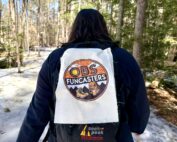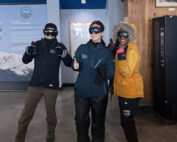Winter Weather Education
2013-02-11 23:09:24.000 – Mike Carmon, Weather Observer/Meteorologist
Winter seems to be fully hitting its stride recently, with plenty of cold air and snow to be had over the last few weeks.
The National Weather Service uses quite an array of terms to describe winter weather events, so much so that there is probably a good deal of confusion in circulation. So, let’s take some time to clarify some of the terms you may hear before, during, and after these events:
Winter Weather Advisory: Issued by the National Weather Service (NWS) when a combination of winter weather is expected (sleet, snow, freezing rain), and will present a hazard, but will not meet warning criteria.
Winter Storm Watch: Issued by NWS when the potential for heavy snow or significant ice accumulations exist. A watch will be issued 24-36 hours in advance of the impending storm.
Winter Storm Warning: Issued by NWS when heavy snow or significant ice accumulations are occurring or imminent. Winter Storm Watches are generally upgraded to a Winter Storm Warning 24 hours in advance of the impending storm, unless there is some change in the forecast.
Blizzard: The technical definition of this phenomenon requires the following criteria to not only be met (in combination with each other), but prevail for a period of 3 hours or longer: sustained winds or frequent wind gusts in excess of 35 mph, and considerable falling and/or blowing snow, frequently reducing visibility to 1/4 mile or less. The threat of a blizzard will warrant a Blizzard Watch, which will be upgraded to a Blizzard Warning 24 hours before the commencement of the event.
Freezing Rain: Precipitation that falls as liquid, but freezes on contact as it strikes the ground due to below-freezing surface temperatures, creating some of the most dangerous travel conditions winter can dish out. A purely freezing rain event, below warning standards, will prompt the issuance of a Freezing Rain Advisory.
Sleet: The technical name for this phenomenon is “ice pellets.” Sleet occurs as snow falls through an elevated warm layer (a layer in the atmosphere with temperatures above freezing) and melts, and then refreezes as it drops below this warm layer before hitting the surface. Pellets of ice are the result of this process, and they are distinguished from snow because they bounce upon hitting hard surfaces.
Alberta Clipper: One variety of winter storm that is named for the location in which it originates–the Alberta province of Canada. Low pressure systems originating in this vicinity can gain strength as they travel east-southeastward and “clip” the northeastern United States, often saving the most significant snows and winds for northern New York and New England. Clipper systems can vary greatly in intensity and effects, from a few inches to a foot of snow. In general, though, these systems are faster-moving and less intense than their headline-grabbing counterparts–Nor’easters.
Nor’easter: A unique type of storm that occurs exclusively in the northeastern United States. A Nor’easter is a coastal low pressure system that rides along the eastern seaboard, intensifying as it treks further north. Although nor’easters can occur year-round, they are much more common in the fall and winter months, and are responsible for the most significant snowfall events in the northeast during the winter. Nor’easters are named for the strong northeast winds they often harbor, along with heavy precipitation.
Mike Carmon, Weather Observer/Meteorologist
Team Flags Return for Seek the Peak’s 25th Anniversary
Team Flags Return for Seek the Peak's 25th Anniversary By MWOBS Staff Mount Washington Observatory is looking forward to continuing a much-loved tradition for Seek the Peak’s 25th Anniversary: Team flags. In inviting teams
Meet Summer Interns Zakiya, Max and Maddie
Meet Summer Interns Zakiya, Max and Maddie By MWOBS Staff We are excited to welcome six teammates to the summit of Mount Washington this summer! During their internship, these students and graduates will play
Saying Goodbye to the Summit
Saying Goodbye to the Summit By Alexis George After an extraordinary last three years working as a Weather Observer and Meteorologist, I am excited to pursue a different career. As sad I as am




